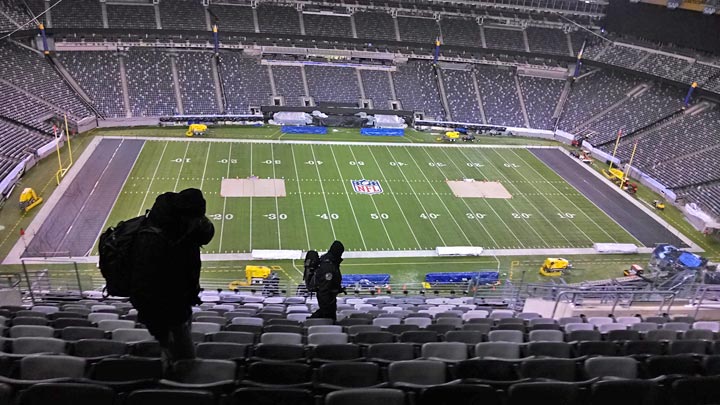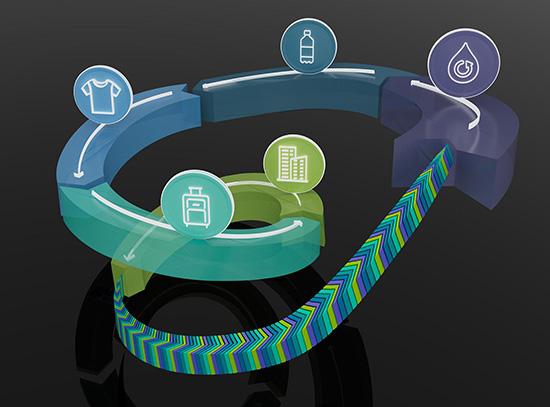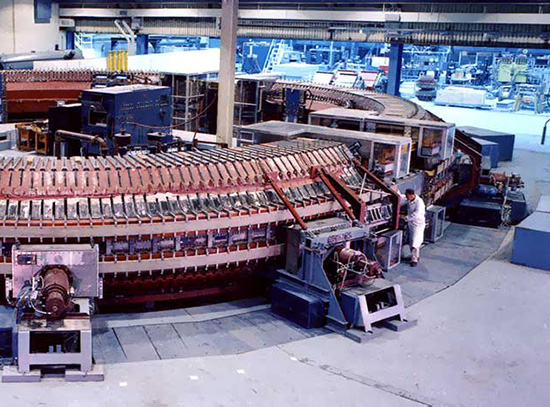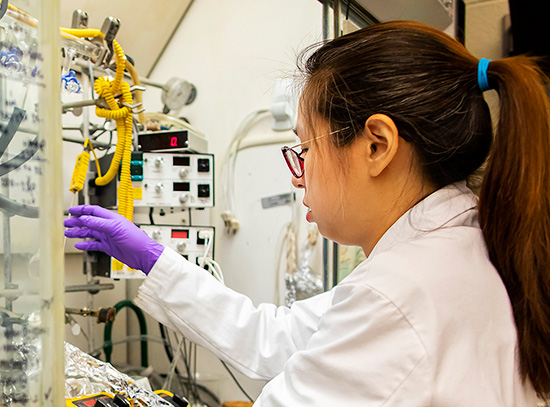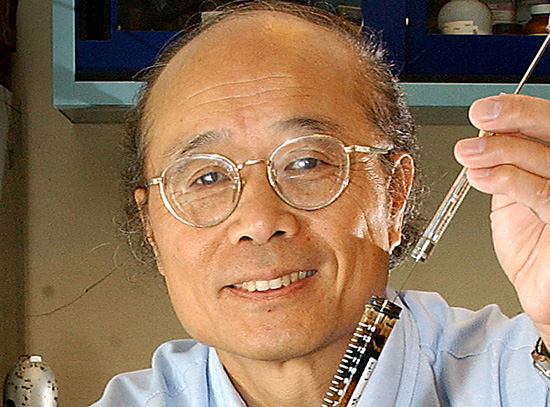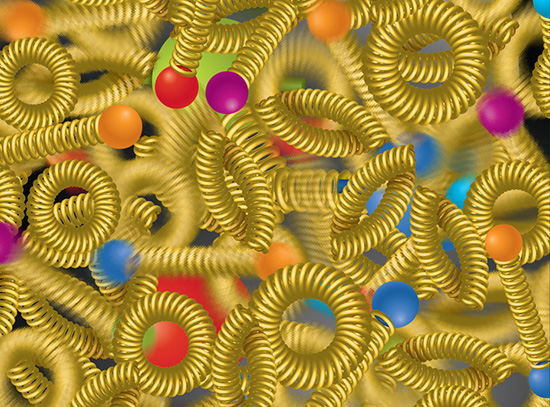The Science of Detecting and Defeating Radiological Threats
April 18, 2014
If you were at the Super Bowl in New Jersey in February, or at the concurrent “NFL Experience” in Manhattan, you may have spotted some elite Brookhaven Lab employees. Not cheering in the stands or even inside the stadium, these members of the Lab’s Radiological Assistance Program (RAP) team were working on Super Bowl Sunday and for several weeks beforehand to monitor the metropolitan area for potential radiological threats.
“We used to investigate questionable material found in grandpa’s basement, but since 9/11 the focus has been on search-and-detect missions.”
— Kathleen McIntyre
The RAP team, one of the National Nuclear Security Administration’s (NNSA) radiological emergency response assets, is comprised of a few permanent staff, augmented by highly trained volunteers from many Lab disciplines. Together, they work to stay ahead of any such threats using a palette of detection tools that have become increasingly sophisticated and user-friendly, driven by the evolving mission of the program.
“The whole profile of the team has changed,” said Kathleen McIntyre, who is the contractor operations manager for RAP Region 1, which covers the East Coast from Maine to Maryland and inland to the Pennsylvania-Ohio border. “We used to investigate questionable material found in grandpa’s basement, but since 9/11 the focus has been on search-and-detect missions.”
Working with first responder partners like the Federal Bureau of Investigation, police and fire departments, hazmat units, Weapons of Mass Destruction Civil Support Teams (Air and Army National Guard), and others, the RAP team offers radiological assistance efforts upon the request of federal, state, tribal, and local governments and private groups and individuals for incidents involving radiological materials. In addition to prominent sporting events, the RAP team supports security efforts for high-profile events like the United Nations General Assembly, New Year’s Eve activities in one or multiple locations, the holiday tree lighting ceremony, the Democratic and Republican national conventions, and even Presidential inaugurations.
During a deployment, researchers and technicians with backgrounds in various aspects of radiological controls and analysis conduct field monitoring and environmental sampling, assessment, and documentation activities to help decision makers choose appropriate protective actions for the safety of both the public and first responders. Between deployments, the team examines issues of coordination between agencies, plans, and procedures, and trains and evaluates the proficiency of individuals using the equipment. Initially, all RAP team members are required to take a specialized course in Albuquerque, NM, and then attend training sessions at least quarterly. Team members are periodically evaluated through their participation in drills and exercises. Occasionally a “No Notice Exercise” is conducted by NNSA that tests the team’s readiness to respond.
Advances in equipment
Although some of the equipment now being used is commercially developed, other instruments are developed specifically for the use of DOE assets such as RAP teams, with the expertise of scientists and engineers from the DOE and NNSA complexes. Lab staff has participated in the development, testing, and functional evaluation of numerous pieces of equipment in this category. The evolution of this equipment conforms to the change in the program’s mission.
Historically the RAP mission was “consequence management” — events and situations along the lines of responding to a spill from a truck carrying medical radioisotopes, for example. But as the profile of terrorism has been raised across the country and around the world, the need for a more preemptive approach in radiological screening was recognized, and RAP has been increasingly called upon to support law enforcement groups conducting directed or random screening for illicit movement of radiological materials.
“That screening tends to be correlated with the potential for radiological material to be used to threaten a large mass gathering or other high-profile event,” said Chuck Finfrock, principal engineer for RAP team science. “To assist us in doing what we call low-profile missions, we need to be able to blend into crowds and collect radiological data in the field. Some of the equipment that we originally had was extremely bulky, so scientists have been working on equipment that is easier and less cumbersome to use and allows us to do a quicker assessment of our environment.”
One of the techniques now being applied to the search and crisis response missions is gamma ray spectroscopy (GRS), largely a laboratory technique used for more than 40 years to identify radiological material. Like a fingerprint, a particular radiological material has a particular gamma ray spectrum that is unique to that radioisotope. As a result, this technique can be used to not only detect the radioactivity of a sample, but also to give information identifying that particular material. The instruments can be very large and are delicate items that need very stable temperature control and a constant supply of liquid nitrogen to cool them.
As the RAP program moves to emergency response, more portable equipment allows the team to conduct a search operation with greater focus. For example, a construction site may report a missing soil density gauge – a commercial product containing some radioactive material that’s used to measure the density of compacted soil. With a spectroscopic system, the team knows in advance what isotope they’re seeking and can use GRS to search in a more specific way. Also, while the older GRS systems always required a human to take, calibrate, and analyze the data, computer software can now automate some analysis of that gamma ray spectral information.
“The instruments are also, in effect, becoming ‘smarter’ and better able to help first responder partners with limited knowledge collect the initial on-scene information. This improves the quality of the data collected, which in turn helps a team scientist to understand the event more quickly,” said McIntyre. “Another important technological change that’s taking place is that instruments are being equipped with the ability to communicate by cell phone, satellite or Wi-Fi, allowing us to send data from the field back to a command center in near real time. Operators in the field working in multiple locations can send data back to the command center to be analyzed by one specialist at the command center.”
Other new, more sophisticated algorithms can generate data products, such as maps, at different stages of an event, so technical information can be conveyed to decision makers at a glance.
Training, teamwork critical
But McIntyre warns that as sophisticated and user friendly that this gear has become, “we cannot emphasize enough how important it is to have an individual who has proficiency in the equipment that is being deployed in the field. Some of the first responders wear many hats, and while they do receive training, they don’t have the kind of in-depth knowledge and access to scientific expertise that members of the RAP team have. There are still important issues related to the fact that we live in a sea of radiation from rocks and soil. Also, we live in a community where radiological materials are used in many medical applications. As an example, we often encounter people who have had a thallium stress test or other medical administration. That person will measure as radioactive for days or weeks.”
“Construction materials can also offer challenges,” she added. “On the streets of New York City, you’ll see great changes in the background radiation levels as you go from avenue to avenue and street to street. Our team has been trained to be cognizant of those changes and those contributing factors as well as being on high alert for something that might contribute additional information that might be of interest.”
The context surrounding a measurement needs to be evaluated by someone with some understanding of the world’s background radiation footprint. The DOE community also has a capability called TRIAGE, where highly trained specialists from the NNSA nuclear weapons laboratories provide a scientific confirmation of the measurements made in the field. Advances in equipment communication allow that information to be communicated to specialists who can analyze field measurements that may look ambiguous.
“The evolution of our capabilities is a combination of advancements in different areas,” Finfrock said “The advancements in detector engineering have caused them to become more field-usable. The advances in communications electronics and computers have enabled the detectors to more easily send data to the right people quickly. Most detectors now have global positioning tagged in with the radiological data, so not only are we getting back radiological measurements but we also know very precisely where that measurement was taken. We can correlate multiple measurements in multiple locations to be able to anticipate situations because we have geospatial awareness as well as radiological awareness.”
As the radiological landscape continues to evolve, both in this country and abroad, the RAP team and others will continue to refine their search and detection techniques, and scientists at Brookhaven Lab and elsewhere will be working to stay ahead of the technology curve.
2014-4728 | INT/EXT | Newsroom




